Roasting Process July 28 2016
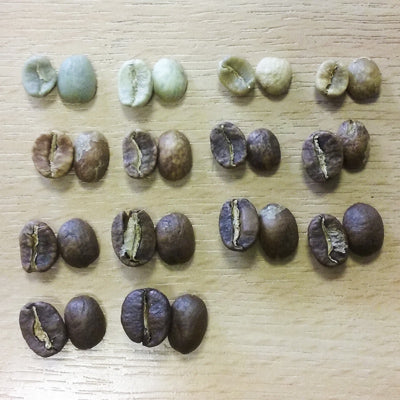
The actual method of roasting coffee can be overlooked at times. Especially when there is such great emphasis on the barista skills required to extract that beautiful espresso. However the taste of that espresso is in large dominated by the roast profile, as it is the determining factor on what flavours are present. The roast profile refers to how the coffee is roasted, what temperature it is roasted at and most importantly when the roasting process is stopped.
In order to understand the different roasts we must first begin to understand what actually happens to the coffee during roasting. The beans go through phases of being endothermic (absorbing heat) and exothermic (exporting heat) which causes them to crack. The beans don't actually break but they make a sound similar to popcorn and will approximately double in size over the roasting process. The beans can crack twice, referred to as first crack and second crack respectively. Most roasters will allow the first crack to completely finish and will rarely roast until the finish of the second crack. Soon after the second crack finishes the beans begin to burn and eventually disintegrate in to ash or cause a fire! You can find out more about the endothermic and exothermic process in our previous blog here.
Below you can see the different stages of roasting, from green bean to Full City+ Roast. The beans that are being hand roasted in the pictures below are from Guatemala and can be found in Bang Bang, Skin the Goat and Johnny Forty Coats.
The lovely signs indicating the time were made with the help of our youngest team member.
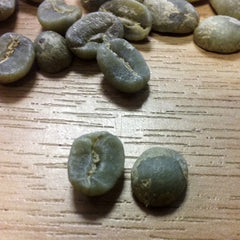
Green Bean
This is the bean un-roasted and raw. The bean is very hard and small. During the roasting process the bean will soften and grow in size.

@ 4.00 minutes
The bean goes from a green colour to a pale green colour. In terms of colour the bean does not change much during this stage. However during this endothermic stage the bean releases water.

@ 6.00 minutes
The bean goes from pale green to a yellowing colour. There is no change in the physical size of the bean.
@ 6.30 minutes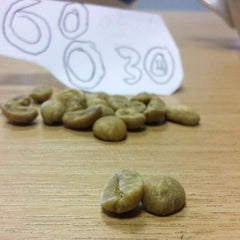
The bean begins to gain a tan colour and is still letting off water in the form of steam.
@ 8.00 minutes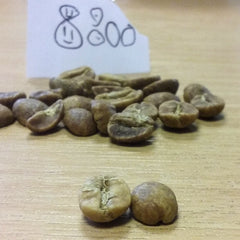
The coffee bean turns from a tan colour to a light brown. The first crack is nearing and the bean starts to expand in size. The browning and aroma occurs due to Maillard reaction where the protein in the coffee combines with the sugar and creates aromatic compounds.

@ 9.00 minutes
The bean has now turned a deeper brown and the first crack will occur within the next minute.
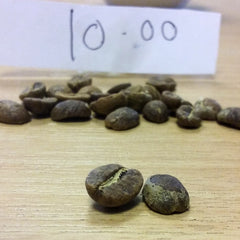
@ 10.00 minutes
The first audible sounds of the first crack can be heard. This is where the bean stops being endothermic and becomes exothermic, it stops absorbing heat and instead gives off heat as the bean cracks. If the roast is stopped here it is considered a Light City Roast or a Cinnamon Roast. The acidity in this roast is very pronounced and it has a grainy taste
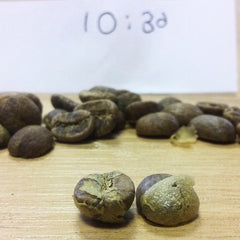
@ 10.30 minutes
The first crack continues. The beans will not have a uniform colour at this stage, but will start visibly expanding in size.

@ 11.00 minutes
Once the beans stop cracking they become endothermic again and start absorbing heat. This is in preparation for the second crack. 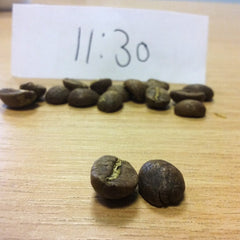 @ 11.30 minutes
@ 11.30 minutes
During this period the bean's surface begins to smooth and the colour becomes more uniform. If the roasting process is stopped here the roast is considered a City Roast or an American Roast. This is considered a medium roast and there is balance of flavour, aroma and acidity but it lacks body. 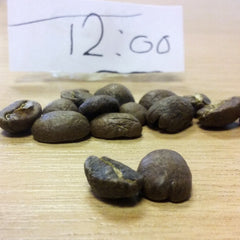 @ 12.00 minutes
@ 12.00 minutes
The length of time between the first crack and the second crack really depends on the person roasting and the specifications of the roast. In some cases the time between the first and the second crack can be a as short as 30 seconds. However the time can be controlled by adjusting the temperature inside the roaster. 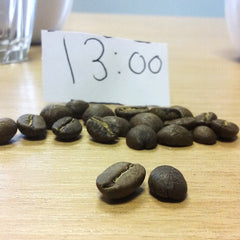 @ 13.00 minutes
@ 13.00 minutes
This is the time just before the second crack. There are no audible signs of the second crack yet, but judging by the temperature the person roasting knows that the second crack is due any second. If the roasting process is stopped here the roast is considered a Full City Roast.
@ 13.30 minutes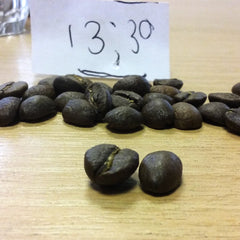
The first audible signs of the second crack become apparent. The beans have at this stage gained a uniform rich brown colour and have almost doubled in size from the green bean. The roasting process for the Guatemalan bean is stopped here and is considered a Full City+ Roast. This is a medium dark roast that has a heavy body in comparison to the previous roasts. The beans are poured out on to a cooling tray and moved around to get the roast to cool down evenly.
If the roasting process is continued a Vienna Roast, French Roast and Espresso Roast can be achieved, to name a few. Both of these roasts are achieved during the second crack. Once the second crack has completely finished the coffee bean has become over a quarter ash and completely unusable. Well, it can probably still be used but it won't be a pleasant experience. Any further roasting will cause the beans to give off smoke and eventually cause a fire. We did not document this process of further roasting for obvious reasons.
The roasting process will vary depending on the person roasting and what they are trying to achieve with the roast. An important factor to consider though is that the temperature controls exactly how long the roast takes and what is achieved. If the temperature is too high there is a chance that the beans will just burn immediately. Additionally if the temperature is too low the beans will not roast properly. Roasting coffee really is a balancing act of ensuring that the temperature is high enough to roast the coffee, but not so high that it burns it.
Once the roast has finished it will be used either in a coffee blend or packaged as a single origin. The roasting process has been done to draw the best flavours out of the bean so you can enjoy every single cup.
